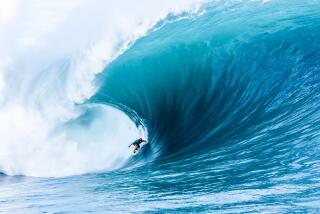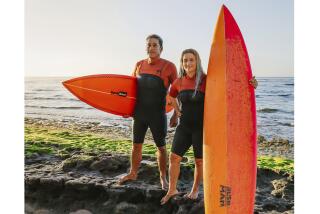A Surfing Passion : Throat Surgery Didn’t End Days on Waves
- Share via
After having his larynx removed, and being left with a hole in his throat, people thought 43-year-old Danny Viveiros’ surfing days were over.
But they thought wrong.
Viveiros, an Oceanside resident who has been surfing since he was 8 years old, suffered from cancer of the larynx. His only option was to undergo surgery, making his chances of surfing again pretty slim.
He knew if he surfed after the operation, he could drown because water would enter the opening in his neck and flow straight to his lungs.
“It (surfing again) was one of the questions I asked the doctor right off the bat,” Viveiros said through his voice machine. “And after the operation I was dying to get back into the water. I knew something had to be done.”
Six months after his September, 1987 operation, recovering well and working again at his plumbing job, Viveiros bought a larchel, a snorkel-like device that allows laryngectomy patients to use a swimming pool. But it was just that, a device for a swimming pool that wouldn’t hold up against a large ocean wave.
Using plumbing parts, wet suit material, automotive parts and the finger from a rubber glove, Viveiros has made the larchel his surfing lifeline. Through much experimen- tation with the device, and almost dying using it, he has perfected it to the point where he now surfs weekly with the same vigor he had before the operation.
The larchel is like a snorkel, but the end of the tube that usually goes above the water to retrieve air actually fits into the hole in Viveiros’ throat. He has made the tube that goes into the hole inflatable by covering it with a durable rubber material--the finger from the glove. He inflates the tube by pumping up an additional longer, skinnier tube.
The device was painful at first, but the more he wears it, the less it bothers him.
“Even if the tube deflated, it wouldn’t come off, because of the Velcro and wet suit collar around my neck,” Viveiros said.
Viveiros said that returning to surfing has made the trauma of his operation much less severe.
He had been depressed after his surgery, and didn’t even want to look at the ocean he had grown to love since his dad taught him to surf as a child. His friends took him fishing, but he was apprehensive about going because he was terrified that his body would fill up with water if he fell in.
But Viveiros’ passion for surfing wouldn’t lessen, even when he slept. He dreamed about surfing and would wake up thinking he had just come from the beach.
“I knew I had to do something or I’d bomb,” he said.
The dreams were the last straw for Viveiros, and he modified the larchel to make it strong enough for ocean use.
“When you grow up by the ocean and you spend so much time there, it’s like you’re losing something in your life,” he said. “You need something to fill the void.”
Filling that void almost killed him.
“I had made about 10 or 12 different devices, and they still weren’t there yet,” he said. “I went surfing with Greg Woods (a good friend) and I pulled a stupid move, something I should have been more careful about.”
The two men were surfing near a jetty in Oceanside, when Viveiros wiped out on a big wave.
“He was feeling real comfortable, and he was pushing his device a little too far,” Woods recalled. “He took off on this bigger wave and it overcame him completely.”
Viveiros landed on the rocks, and lost the precious device. Woods managed to get him onto the beach.
“The whole time he was coughing and choking, and barely getting any air,” Woods said. “He was sitting on his knees and kept motioning toward his feet. He couldn’t talk to me because he didn’t have his machine. I figured it out, and grabbed him by both ankles and lifted him upside down into the air.
“About a gallon and a half of water came out of his lungs. I held him up again and he said that was enough. I told him I would never surf with him again if he kept pushing the device.”
The incident scared Viveiros, but made him that much more determined to perfect the larchel, which he thinks he has done. He has used the perfected version, which he simply calls his “device,” for about three months.
“He is still the same surfer, real competitive and one of the better, cleaner surfers I know,” Woods said. “If he didn’t have surfing, I don’t know what Danny would do. It’s scary to even think. I admire Danny for not only being my friend but for not giving up when the chips are down. Everyone had written him off as a surfer. I really do admire him.”
Longtime friend and Oceanside surfboard manufacturer Donald Takayama said Viveiros is a “hell of a surfer,” who has made him realize how fortunate he is for being able to surf without worrying about drowning.
Viveiros said his family and doctor have been supportive of his surfing since the operation. And his friends are always there when he needs them.
Other surfers in Oceanside look at Viveiros in the water and ask the most off-the-wall questions, he said. But his surfing buddies are always there to explain the situation, and watch over him to make sure he comes up from the waves.
“A lot of people do look at me, and I can see that they’re digging it just as much as I am,” Viveiros said. “The object is to keep yourself busy and not sit around and feel sorry for yourself.”
More to Read
Sign up for Essential California
The most important California stories and recommendations in your inbox every morning.
You may occasionally receive promotional content from the Los Angeles Times.










